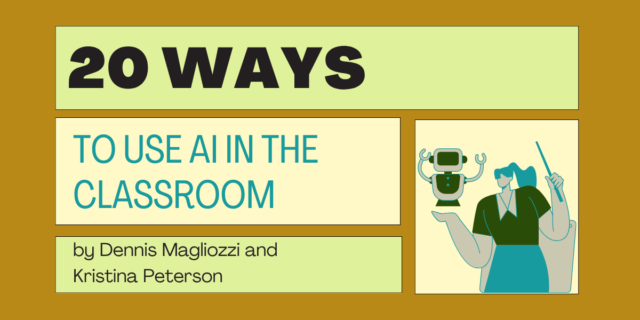
The following is excerpted from A Teacher’s Guide to Mentor Texts by Allison Marchetti and Rebekah O’Dell.
The following is excerpted from A Teacher’s Guide to Mentor Texts by Allison Marchetti and Rebekah O’Dell.
Why Mentor Texts?
Mentor Texts Help Writing Teachers . . .
Diversify the Teaching Voices in the Classroom
With mentor texts at the center of our writing instruction, we don’t have to be everything to every student writer. The writers behind the mentor texts—representing diverse backgrounds and perspectives—are also teachers. Students are more likely to take their writing to the next level when they can learn from writers who look like them, have similar life experiences, and articulate viewpoints like their own.
Teach Writing Authentically
When we gather professional examples of the kind of writing we want our students to create and we study it for structure and craft, the skills that are important to teach come clearly into focus. If the mentor writers layer evidence through hyperlinks, we need to teach our writers to layer evidence through hyperlinks. If the mentor writers conclude by zooming out to the global importance of the issue, we need to teach our writers to do the same. Our instruction is rooted not in curriculum guides and pacing charts, but in the expectations of real-world writing and the needs of our students.
Multiply Instructional Power
With a little experience, students learn that they can find the answers to their writing problems in mentor texts. They learn to turn to these other “teachers” for guidance and often find solutions to their writing problems without even needing our support. With mentor texts, every desk has multiple teachers by its side.
Strengthen the Reading Curriculum
When students study a mentor text to discover ideas, and then return to it to help them organize their thoughts, and then search it again for guidance on crafting stronger sentences, and examine it as they polish their writing, they are digging deep and reading with an engagement that is uncommon in most reading curricula.
Streamline Planning and Reduce Instructional Decision Fatigue
Instead of spending hours reinventing the wheel with each unit (or spending money to buy units from others), we can rely on the planning routine we use with mentor texts to work for every kind of writing we need to teach—both genres we know by heart and genres we’ve never taught before. It works for first-grade writers and college writers. It’s the safe, simple place we return to each time we need to plan a writing unit.
Mentor Texts Help Student Writers…
Practice Authentic Patterns of Learning
Studying mentor texts isn’t a school skill; it’s a life skill. If we want to learn to do anything better, we study the work of experts—whether it’s Ina Garten baking a tart on TV or Steph Curry making a three-pointer. We watch those we admire in action, take note, and then try it ourselves. Learning to write is a similarly intuited “craft apprenticeship” (Ray 1999, 10).
Build Writing Identity
When we study mentor texts with our students, we invite them to pull up a seat at the same table as the pros, and we send the message, “Yep, you can do that, too, because you’re a writer.” When students see themselves this way, they are able to play, take risks, and add their voice to a larger community of working writers.
Make Authentic Writing
Professional writers in the wild compose poems and op-eds and short stories and reviews and essays and listicles and feature articles. They don’t write “five-paragraph essays” or “research papers”—school writing. We can prepare our students for academic writing tasks when we invite them to make the kind of writing real writers make.
Face Future Writing Challenges
We can’t prepare students for every kind of academic, personal, and professional writing they will need to do in their lives. But we can teach them the transferable skill of reading like writers and finding the craft and structure they need for the writing task at hand. With ample practice, students will know how to find and use mentor texts whenever they need them—to write a paper for a professor or a memo for a boss, for example. To learn more about A Teacher’s Guide to Mentor Texts visit Heinemann.com.
To learn more about A Teacher’s Guide to Mentor Texts visit Heinemann.com.
 Allison Marchetti is coauthor—with Rebekah O'Dell—of Writing with Mentors and Beyond Literary Analysis. Their popular blog Moving Writers focuses on writing instruction in middle and high school classrooms with an emphasis on voice and authenticity. Traveling the country to work with teachers and students provides constant inspiration as they help educators do the hard-and-transformative work of teaching real writing.
Allison Marchetti is coauthor—with Rebekah O'Dell—of Writing with Mentors and Beyond Literary Analysis. Their popular blog Moving Writers focuses on writing instruction in middle and high school classrooms with an emphasis on voice and authenticity. Traveling the country to work with teachers and students provides constant inspiration as they help educators do the hard-and-transformative work of teaching real writing.
Allison has taught middle and high school English in both public and independent schools in Richmond, Virginia. Her favorite moments in the classroom happen at students’ desks, thinking and reading and writing beside them.

Rebekah O'Dell is coauthor—with Allison Marchetti—of Writing with Mentors and Beyond Literary Analysis. Their popular blog Moving Writers focuses on writing instruction in middle and high school classrooms with an emphasis on voice and authenticity. Traveling the country to work with teachers and students provides constant inspiration as they help educators do the hard-and-transformative work of teaching real writing.
After more than a decade in the high school classroom, Rebekah currently teaches middle school English in Richmond, Virginia. She has experience using the reading and writing workshop model to transform student engagement at all levels, from inclusion classrooms to the International Baccalaureate program.


